Which one of these amazing, budget-friendly TVs is the best?
We take an in-depth look at two of the most value-packed TVs you can buy
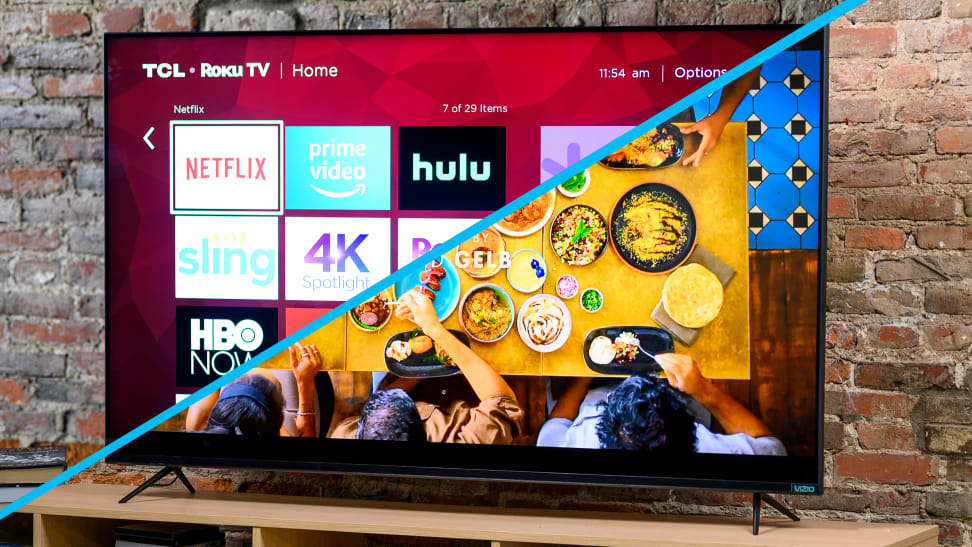 Credit:
Reviewed / Jackson Ruckar
Credit:
Reviewed / Jackson Ruckar
Products are chosen independently by our editors. Purchases made through our links may earn us a commission.
While it’s nice to daydream about buying the best TV money can buy, at the end of the day, most of us will find ourselves hunting for a bargain.
But bargain hunting doesn’t mean you’ve got to settle for a basement-level TV. The Vizio M Series Quantum and the 2019 TCL 6-Series are proof of that.
Both of these 4K/HDR quantum dot TVs offer the sort of performance that would’ve been unheard of in their price bracket a few years ago, in part due to the fact that, until recently, such displays were incredibly expensive to produce. That’s why these two TVs were destined for a head-to-head comparison.
Fortunately, we’ve taken both of them for an extensive spin through our TV-testing lab as well as using them in real-world environments to put them to the test. While both TVs angle for the same spot in the marketplace, the M Series Quantum and the 6-Series are worlds apart. Let’s get into it.
Inputs
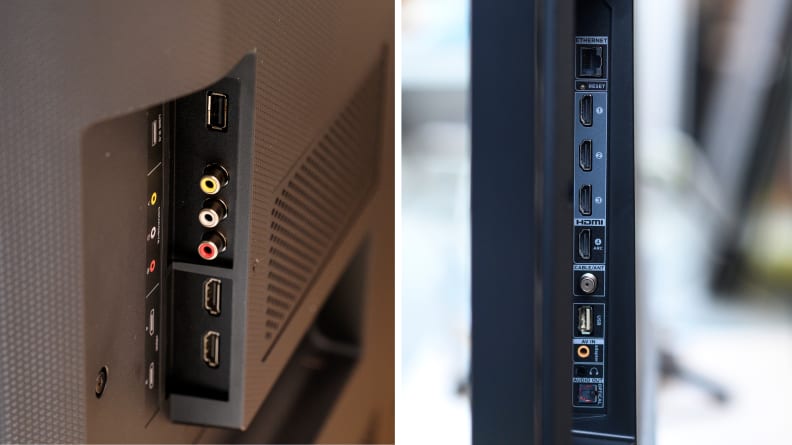
Left: Vizio M Series Quantum inputs | Right: TCL 6-Series (2019) inputs
Both the Vizio M Series Quantum and the TCL 6-Series feature four HDMI 2.0 ports (including an HDMI ARC port) and a single USB 2.0 port. Both TVs also come equipped with a digital optical audio output and a standard RF jack (in case you want to connect an HD antenna). For most folks, these are more than enough options to furnish a full suite of AV equipment.
The M Series features dedicated component inputs—those red, white, and yellow jacks we’re all familiar with—while the 6-Series offers those inputs in the form of a 3.5mm splitter cable accessory that comes with the TV. Another difference? TCL slapped a 3.5mm audio jack on the back of the 6-Series—because it’s good enough for a TV, but not your smartphone.
Who’s got the edge? By default we’ve got to give this one to the TCL 6-Series, though it’s worth noting that both of these TVs offer roughly the same, slightly-above-average input selection.
Design
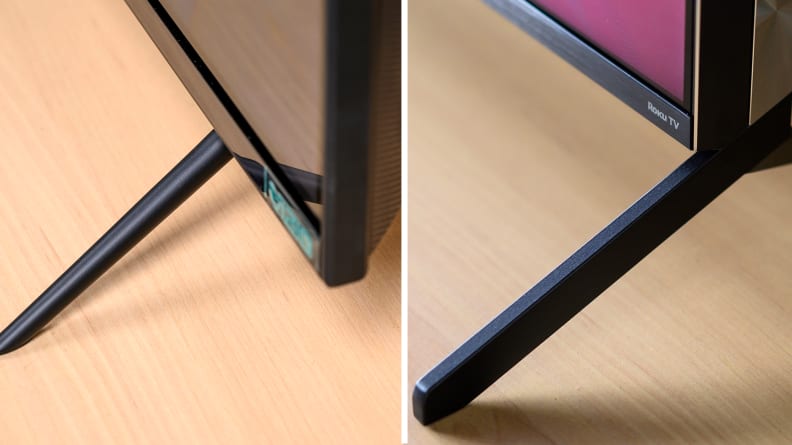
Left: Vizio M Series Quantum stand design| Right: TCL 6-Series (2019) stand design
When it comes to look, feel, and overall build quality, both the Vizio M Series Quantum and the TCL 6-Series opt for quiet professionalism over head-turning elegance. In other words, you’re looking at a big, square panel on top of a couple of feet stands.
The M Series Quantum continues the Vizio tradition of recent years wherein wide-set, boomerang-style feet flank a hefty, backlit display wrapped in narrow bezels. This varietal happens to be matte charcoal rather than the posh, platinum feet that emblazon Vizio’s more-premium offerings.
The TCL 6-Series is similar in its approach, but its feet are more angular and pushed even further to the edge of the panel—flushed right with the edge, as a matter of fact. Because of this placement, the feet are also pointed inward towards the center of the display, rather than outward like the M Series. Up top, the 6-Series’ bezels are impressively narrow, but like the M Series, the 6-Series is chunky due to its backlit design.
Who’s got the edge? It’s important to remember that, in the absence of a wall mount operation, both of these TVs will require a relatively large surface to accommodate these wide-set feet. Both the M Series and the 6-Series offer ample real estate beneath the screen for soundbars, too.
In fact, from a functionality standpoint, neither of these TVs has a leg up on the other. This means that the winner here comes down to personal taste. For my money, the Vizio M Series Quantum is the slicker of the two models, but not by much—and only because I like the look of its feet more.
Features
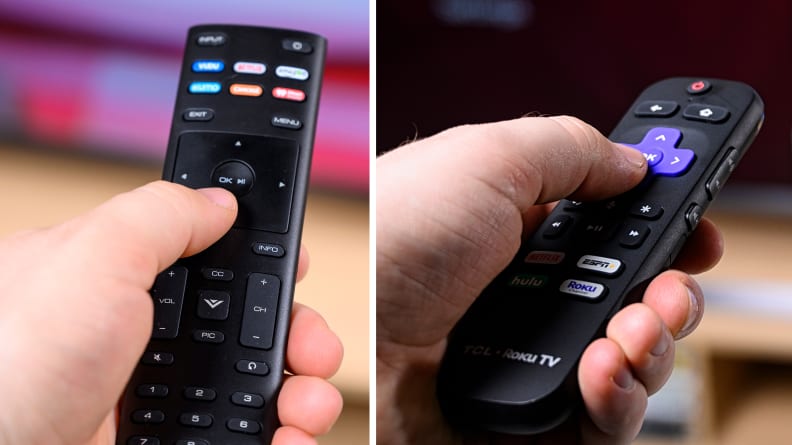
Left: Vizio M Series Quantum remote control | Right: TCL 6-Series (2019) Roku remote control
We’ll get into the M Series’ and 6-Series’ respective smart platforms in a bit, but for now, let’s take a look at some of the key features each of these TVs brings to the table.
When it comes to HDR formats, both TVs support HDR10, HLG, and crucially, Dolby Vision. We’ve covered the difference between HDR10 and Dolby Vision in the past, but allow us to nutshell it for you: Of the two formats, Dolby Vision is the more stringent, so in practice, TVs that support Dolby Vision can hang their hats on the certification.
Unsurprisingly, both the M Series and the 6-Series come with a remote, but we much prefer the contours, buttons, and responsiveness of the Roku remote that comes bundled with the 6-Series, and we think you will, too. Vizio’s M Series remote is fine, but its buttons are flat, squishy, and far too copious.
Both of these TVs offer a full array of calibration tools (if that’s your thing) as well as an assortment of motion enhancement options that we hope you won’t tinker with too much.
Who’s got the edge? Folks, we hate to say it, but this one came down to the clicker, giving the TCL 6-series the edge by a hair. If what you’re after is an affordable Dolby Vision TV with some flexible software, both the 6-Series and the M Series Quantum have you covered.
Performance
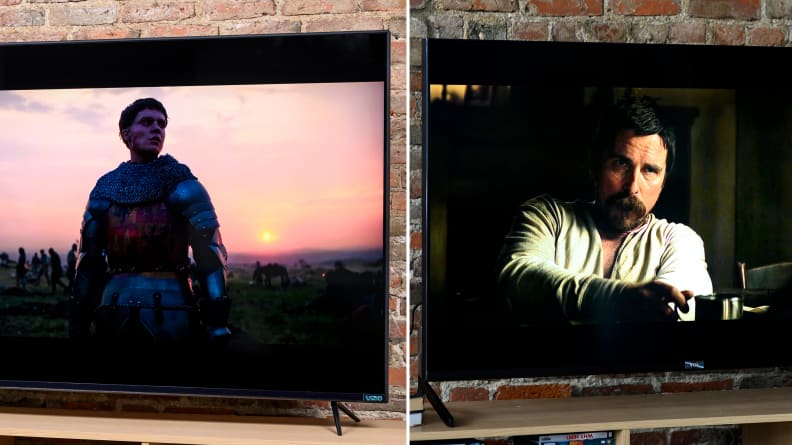
Left: Vizio M Series Quantum with HDR content Right: TCL 6-Series (2019) with HDR content
Here’s how the Vizio M Series Quantum and the TCL 6-Series stack up in each of the major performance categories.
1. Contrast (Peak Brightness and Black Level) Being quantum dot TVs, you can expect bright, colorful things from both, even if they’re not nearly as bright as some of the best QLED TVs available today.
In our lab tests, the Vizio M Series Quantum averaged between 450 and 550 nits of brightness during HDR content, and its black level measurements hovered at around 0.050 nits. Our test unit was the 65-inch M658-G1, and although performance of each M Series model varies depending on which you happen to buy, none of them reportedly get much brighter than 600 nits. Still, for a HDR TV in this price range, these figures are great.
Our 55-inch TCL 6-Series, on the other hand, climbed as high as 450 nits during SDR content, and in HDR, was able to surpass the 850-nit mark at its brightest. Its black levels are respectable, too; we measured an average of around 0.075 nits for most content.
Now, these figures don’t exactly reflect what you can expect to see every time you turn these TVs on, but it does give you an idea of what both of them are capable of when their hardware is pushed to the extreme. With that in mind, the TCL 6-Series is demonstrably the brighter, more dynamic of the two.
2. Color
When it comes to color, quantum dots are the bees’ knees. The 6-Series and the M Series Quantum both offer the type of color production you’d expect to see from a quantum dot TV, though neither of which is as stupefyingly colorful as some of the priciest flagship QLED TVs we’ve tested.
The M Series Quantum covers roughly 97% of the Rec.709 color gamut—near perfect for most content—and about 95% of the expanded P3 gamut, which is what you can expect to see from properly mastered HDR content. Colors on the M Series pop across the board, though you can expect some desaturation and discoloration when you view from an off-angle.
In our lab tests, the 6-Series put up similar numbers, though ultimately couldn’t match the M Series Quantum. It covered about 93% of the Rec.709 color space and 94% of the P3 space. Were you to compare them side-by-side in the wild you’d almost certainly spot some differences, but both will ultimately look great—and better than most non-quantum TVs in this price bracket.
3. Viewing Angle
If you were hoping for one of these TVs to come out on top in the viewing angle match-up, I’ve got some bad news: Both the M Series and the 6-Series struggle equally in this department. Once you move about three or four feet away from a direct, head-on angle, you’ll begin to notice a degradation in picture quality—a drop in contrast and, in some cases, an abundance of light bloom.
4. Motion Handling
Since both the M Series Quantum and the TCL 6-Series feature a native refresh rate of 60 Hz, neither of these TVs really has a leg up on the other when it comes to motion handling.
Both TVs exhibit a small amount of judder, but not a particularly severe amount for 60 Hz TVs. If you’re jumping over to one of these TVs from a model that does feature a refresh rate of 120 Hz, you’ll probably notice a dip in quality, but most folks shouldn’t worry about how either the 6-Series or the M Series handle motion.
Who’s got the edge? It’s the TCL 6-Series, but not by much. In fact, unless you plan on putting your new TV in a bright room, I would give the M Series a good, hard look—its colors are a little richer, which helps bring out more detail in the picture.
Still, it’s hard not to ignore how much brighter the 6-Series gets. It's miles ahead of most TVs in this price range.
Smart Platform
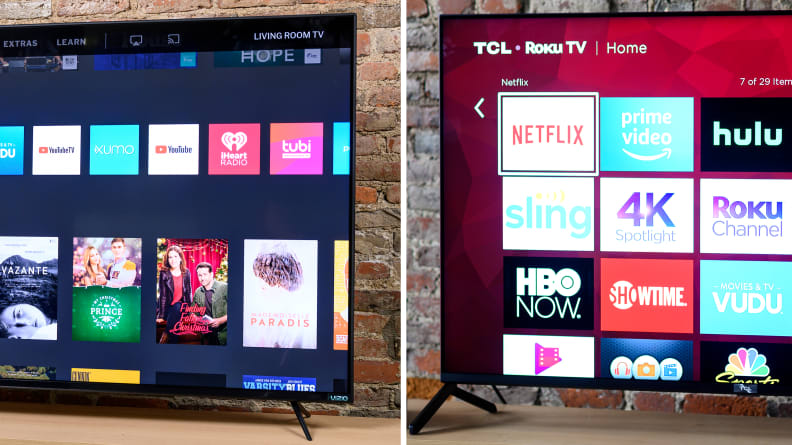
Left: Vizio M Series Quantum Vizio SmartCast 3.0 smart platform | Right: TCL 6-Series (2019) Roku smart platform
Like just about every TV on the market in 2020, both the Vizio M Series Quantum and the TCL 6-Series arrive with a built-in smart platform for accessing popular apps and content streams.
The M Series Quantum features the third generation of Vizio’s proprietary smart platform, SmartCast. With it, M Series Quantum users are given access to a collection of pre-installed apps that include heavy hitters Netflix, Hulu, and Amazon Prime. In addition, SmartCast 3.0 also supports Chromecast, allowing folks to stream video from phones and other Chromecast-enabled devices.
Unfortunately, SmartCast does not offer an app store, meaning users are stuck choosing from the pre-installed app suite or streaming via Chromecast. It’s fine as a fallback, but we recommend Vizio TV owners supplement the experience with an external streaming device.
The TCL 6-Series, on the other hand, is a Roku TV which takes everything we love about our favorite streaming device right out of the box. We love the Roku platform because of its simple layout and fast response time, but it’s also a luxury to have the option of expanding your app catalogue with thousands of apps by way of the Roku Channel store.
Who’s got the edge? This one was easy: The TCL 6-Series wins by a country mile. While Vizio’s SmartCast platform certainly won’t leave you high and dry, Roku OS is superior in nearly every way. It’s faster than SmartCast, easier to navigate, and offers a whole world of flexibility that SmartCast simply cannot compete with.
Price
The best thing about the M Series and the 6-Series is their affordability. The TCL 6-Series is available in two sizes—55 inches and 65 inches—the smaller of which starts at around $600. If you’re lucky, you might even be able to find it for less than that, seeing as how it’s a 2019 model.
The M Series, on the other hand, is similarly priced, but there are ten different variants total, ranging from 43 inches all the way up to 70 inches. There are also multiple versions of some sizes, each varying in terms of hardware. A 55-inch M Series, for example, might cost you $499, $549, or $699, depending on if you buy the M556-G4, the M558-G1, or the M557-G0.
Confused? We don’t blame you. In his review of the M Series Quantum, Reviewed's Home Theater Editor Lee Neikirk covered the difference between each Vizio M Series model, and we highly recommend taking a look at the breakdown.
Who’s got the edge? This one’s a tie between the 6-Series and the M Series.
The 6-Series is a simple, easy-to-understand bargain: You can land a 55-inch quantum dot TV for about $600 or a 65-inch version for about $900, and both of these deals are a slam dunk.
It’s a bit trickier to weigh the value of each of the M Series Quantum’s ten models, but there are far more price points and sizes to choose from, depending on your needs.
Which Should You Buy: The Vizio M Series Quantum or the TCL 6-Series?
Both the Vizio M Series Quantum and the TCL 6-Series offer tremendous value. No matter which one you pick, you're choosing an excellent TV with the sort of hardware and performance we're accustomed to seeing in higher price brackets.
That said, of the two models, we feel that the TCL 6-Series is the better pick for most people, if only by a slim margin. The 6-Series gets considerably brighter than the M Series, meaning it'll accommodate more people, especially folks with bright living rooms. Additionally, the 6-Series' built-in Roku software is miles ahead of the M Series' SmartCast platform.
Don't discount the M Series Quantum just yet, though—you might be better off picking it over the 6-Series. After all, there are eight more variants in the M Series lineup ranging from 43 inches to 70 inches. While the 6-Series is limited to 55- and 65-inch models that start at around $600, the M Series starts at $349 for the smallest model. There are three different 55-inch versions of the M Series alone, all with different specs and price tags. If you want to explore your options—particularly if you're on a tight budget—it's worth seeing what the M Series Quantum lineup has to offer.
Whichever one you pick is a winner, though.
Get the 55-inch TCL 6-Series (2019) from Amazon for $549
Get the 55-inch Vizio M Series Quantum (M558-G1) from Amazon for $549.99
